According to new amendments of MARPOL Annex I Regulation 12, all ships should comply with this requirement not later than the first renewal survey carried out on or after 1 January 2017. Most of vessels laid or been at a similar stage of construction on or after 31 December 1990, the below requirements have already been applied.
Oil residue (sludge) may be disposed of directly from the oil residue (sludge) tank(s) to reception facilities through the standard discharge connection referred to in regulation 13, or to any other approved means of disposal of oil residue (sludge), such as an incinerator, auxiliary boiler suitable for burning oil residues (sludge) or other acceptable means which shall be annotated in item 3.2 of the Supplement to IOPP Certificate Form A or B.
Oil residue (sludge) tank(s) shall be provided and shall be of adequate capacity, having regard to the type of machinery and length of voyage, to receive the oil residues (sludge) which cannot be dealt with otherwise in accordance with the requirements of this Annex. Oil residue (sludge) tank(s) shall be provided with a designated pump that is capable of taking suction from the oil residue (sludge) tank(s) for disposal of oil residue (sludge) by means as described in regulation 12.2.
Oil residue (sludge) tank(s) shall not be arranged with any piping that has direct connection overboard, other than the standard discharge connection referred to in regulation 13. Oil residue (sludge) tank(s) shall be designed and constructed so as to facilitate their cleaning and the discharge of residues to reception facilities.
New amendments result that sludge tanks cannot have any discharge possibilities to the bilge system or tank top, besides the following exemptions:

– The sludge tank(s) may be fitted with drains, with manually operated self-closing valves and arrangements for subsequent visual monitoring of the settled water, that lead to an oily bilge water holding tank or bilge well, or an alternative arrangement, provided such arrangement does not connect directly to the bilge discharge piping system.
– The sludge tank discharge piping and bilge-water piping may be connected to a common piping leading to the standard discharge connection; the connection of both systems to the possible common piping leading to the standard discharge connection shall not allow for the transfer of sludge to the bilge system.
Visual monitoring should preferably be made by a hopper, or alternatively a sight glass. A screw down non-return valve in lines connecting to the standard discharge connection, provides an acceptable means for not allowing for the transfer of sludge to the bilge system.
In cases where the sludge system and/or the bilge system are to be modified to comply with the above requirements, the approval of the modified drawings in addition to the inspection will be required. If the above requirements are already satisfied by the current arrangements, such modification is not required.
Source: MEPC.266(68)
Contact us to receive a professional advisory in your area of interest.
